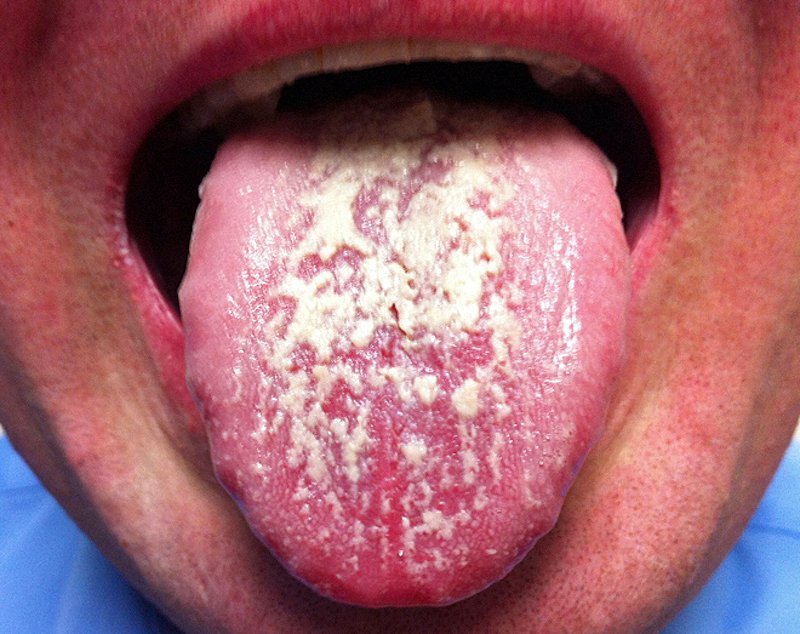Question of the Week - June 2023
June 14, 2023
A 62-year-old man with a history of HIV/AIDS presents to the clinic with a lesion on his tongue, as shown below. Of the following, what is the most appropriate pharmacotherapy?
A. Acyclovir
B. Nystatin
C. Penicillin
D. Griseofulvin
E. Terbinafine
-
Correct Answer: B
Explanation: The thick white patches on this patient’s oral mucosa are suggestive of oral thrush (oropharyngeal candidiasis), a localized infection with Candida fungi. It is associated with immunosuppression and frequently occurs in patients with HIV infection, diabetes mellitus, and history of cancer. In immunocompetent patients, localized oropharyngeal candidiasis is managed with topical antifungals, such as nystatin “swish and swallow” or oral fluconazole. Acyclovir (A) is an antiviral agent effective against herpes simplex virus and varicella zoster virus. Penicillin (C) is an beta-lactam antibiotic used to treat bacterial—not fungal—infections. Griseofulvin (D) and Terbinafine (E) are used for dermatophytoses, not candidiasis.
Image Credit: Photograph from David H. Spach, MD https://www.hiv.uw.edu/go/basic-primary-care/oral-manifestations/core-concept/all
References:
Patton LL, Bonito AJ, Shugars DA. A systematic review of the effectiveness of antifungal drugs for the prevention and treatment of oropharyngeal candidiasis in HIV-positive patients. Oral Surg Oral Med Oral Pathol Oral Radiol Endod. 2001;92(2):170-179. doi:10.1067/moe.2001.116600
June 28, 2023
A 55-year-old female patient with a known history of poorly controlled diabetes mellitus presents with persistent headache, nasal congestion, and facial pain for the past two months. On examination, you note necrotic black eschar in the nasal cavity. Nasal endoscopy reveals deviated nasal septum and pale, edematous mucosa with black discoloration. Non-contrast CT sinus findings include hypoattenuated mucosal thickening in the nasal cavity with local bony erosion. Based on these findings, which of the following is the most appropriate management approach for this patient?
A) Topical corticosteroids and nasal saline irrigation
B) Oral antihistamines and intranasal corticosteroids
C) Surgical debridement and systemic antifungal therapy
D) Oral antibiotics and antipyretics
E) Observation and reassurance
-
Correct Answer: C
Explanation: The clinical presentation of necrotic black eschar, pale and edematous mucosa with black discoloration, along with a history of poorly controlled diabetes, raises suspicion for invasive fungal sinusitis. This condition is a potentially life-threatening infection characterized by invasive fungal growth within the sinuses and surrounding structures. Immediate management of invasive fungal sinusitis involves a combination of surgical debridement and systemic antifungal therapy. Surgical debridement aims to remove necrotic tissue and fungal elements from the affected sinuses, thereby reducing the fungal burden and improving the efficacy of antifungal treatment. It also helps to restore sinus drainage and facilitate the delivery of antifungal agents. Systemic antifungal therapy is essential to treat the underlying fungal infection. Agents such as amphotericin B or voriconazole are commonly used for invasive fungal sinusitis, with the choice depending on the specific fungal species involved and patient factors.
Options A and B are more appropriate for conditions like allergic rhinitis or nasal polyps, which are characterized by chronic inflammation, which would present with pale, edematous mucosa, but not black eschar. Option D involving oral antibiotics and antipyretics would not be effective against the underlying fungal infection and is not the appropriate management for invasive fungal sinusitis. Option E of observation and reassurance is not suitable for invasive fungal sinusitis as it requires prompt intervention to prevent further progression of the infection.
Image Credit:
Chae HK, Lim J, Lee SC, Kim KS. The Significance of "Black Turbinate Sign" on MRI. Ear Nose Throat J. 2020 Jul;99(6):395-396. doi: 10.1177/0145561319847628. Epub 2019 May 9. PMID: 31072199. [Link]
References:
Deutsch PG, Whittaker J, Prasad S. Invasive and Non-Invasive Fungal Rhinosinusitis-A Review and Update of the Evidence. Medicina (Kaunas). 2019 Jun 28;55(7):319. doi: 10.3390/medicina55070319. PMID: 31261788 [Article Link]

